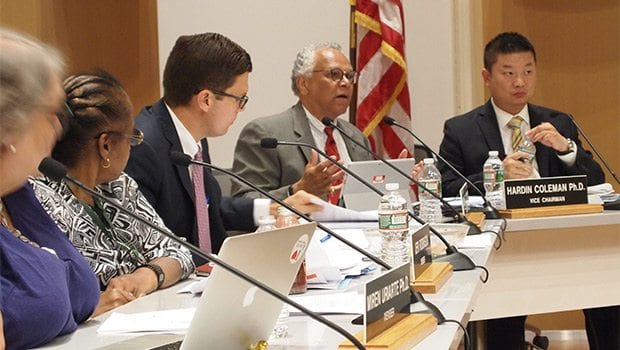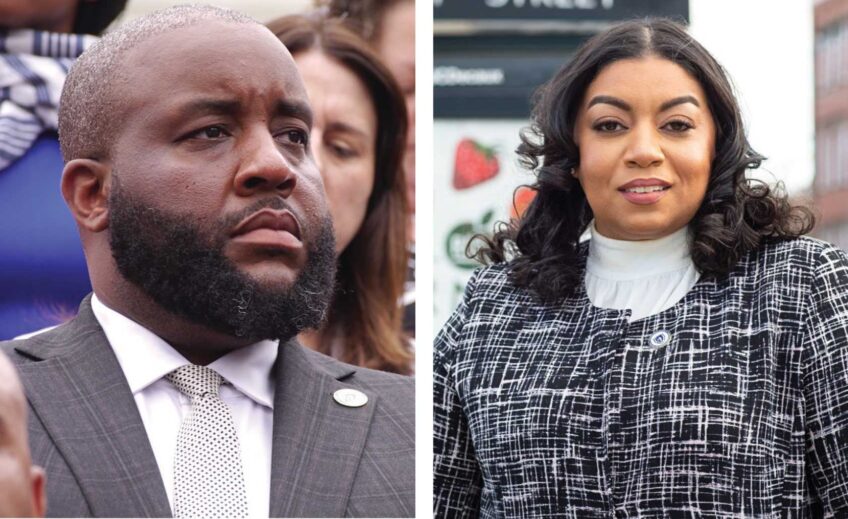
The strained finances of the Boston Public Schools were center focus in a School Committee meeting last week. Officials, committee members and other attendees spoke on the impact of this year’s budget shortfall, including classes teeming with students and schools without libraries.
Several city officials and committee members also said that charter schools, under the state’s current funding structure, have a negative impact on district schools’ resources. The statewide ballot measure that would lift the cap lacks provisions to ameliorate this impact or shelter district schools from the cost being exacerbated, they said. Many who spoke against ballot question 2 were careful to add that their stance did not reflect on the quality of charter schools, but solely on the financial implications of an expansion decoupled from a funding mechanism.
School Committee Chair Michael O’Neill and Vice Chair Hardin Coleman presented a draft resolution against the cap lift, calling it a poor alternative to reforming finance and other issues. The committee will vote the resolution on October 5.
Financial impact
Katie Hammer, city budget director, and Eleanor Laurans, BPS executive director of school finance, told the committee that even with the cap, Boston’s district schools experience a financial burden from charter schools, and that the burden would increase dramatically with the number of charter seats.
“As currently structured, state law disadvantages BPS finances relative to charter schools,” Hammer said.
In part this is because during the past three years, the state has not provided temporary reimbursements to help district school accommodate the fact that their overhead and faculty costs remain the same even as funding follows children to charters.
Another fiscal disadvantage, Laurans and Hammer said, is that BPS pays for charter school students’ transportation. This also is costlier because charters have citywide enrollment, incurring greater travel distances, and the varied start times prevent better cost efficiency.
BPS also enrolls proportionally more students with the kinds of intensive disabilities that make their education particularly expensive, such as being blind or deaf, Laurans said. When the state calculates what it considers an adequate education budget, it does not distinguish between the different costs of educating students with disabilities who have high levels of needs versus milder levels.
In part to compensate for this undercalculation, Boston kicks in additional spending — in fiscal year 2017, this was about 27 percent more than required under the state’s formula, according to Laurans and Hammer’s report.
However, when it comes to setting charter school tuitions, the state requires the city to pay the same 27 percent extra per pupil on charter students as well, without regard to whether students’ disability levels are equally high. Thus, if BPS continues to have a greater concentration of high needs students, the city will continue to provide this extra money to charter schools. If the state continues to underfund transitional reimbursement, city finances could be increasingly burdened.
Marty Walz — former state representative and current head of public affairs, executive management and employment law advisory company Walz and Associates — contested the stance that charter schools impact BPS finances, arguing that charter tuitions are not taken from the BPS budget.
“The contention that the Boston Public School budget is being affected by charter school tuition is not accurate,” Walz said. “The charter school tuition the city pays is not coming from the BPS budget.”
Tuition does, however, come from the city’s budget, thus reducing the pool it has available to allocate not just to BPS, but to police, libraries and all other departments, committee member Michael Loconto noted. The ballot question is then, he said, a question of how much pressure voters are willing to put on the entire city budget.
Speaking during public testimony, KIPP Academy Boston charter school parent Pertreena Cherrie expressed frustration that BPS’ dispute with the state’s education funding practices has generated opposition to charter school expansion. Cherrie said that the cap blocks her child from being able to continue on to high school in an environment in which she thrives, and that BPS should address its funding concerns through advocacy to the state government, not opposition to the ballot measure.
“It sounds to me like district schools need to take up their issues with the state and not prevent my child having an opportunity,” she said.
Eyes on Boston
Some saw the cap lift as likely to have a heightened impact on Boston, as it has hit its cap limit.
“Question 2 is all about Boston,” said Mary Battenfeld, member of the Citywide Parent Council and the parent group Quality Education for Every Student, during public testimony.
Earlier this year, Dom Slowey, media contact for Massachusetts Public Charter School Association, said that Holyoke, Fall River, Cambridge, Somerville, Lawrence, Malden, North Adams and Greenfield also are at their seat limit.
School Committee Chair O’Neill expressed concern that Boston will not have control over if and how charters expand within the city, and that the Department of Elementary and Secondary Education, which will have say, has stated that it does not consider financial impact on local communities when approving charter schools.
Short on books
Gabi Pereire, a junior at Excel High School, said this year’s budget shortfall hit her school hard, resulting in statistics classes without textbooks and AP Language Arts classes packed with 40 students each.
“I don’t know how I’m expected to learn or hear myself think,” she said. “There are teachers who are unable to teach because they are so overwhelmed.”
Another sign of budget strains: Out of 126 BPS schools, 73 are without library services. Thirty-six of these schools are in disadvantaged neighborhoods.
Deborah Lang Froggatt, BPS director of Library Services, presented plans to restore access to library service — although not necessarily to a library itself — to all schools over the course of five years. About 15 schools would gain access per year.
Restoration plans include cultivating partnerships with city library branches, deploying floating librarians to travel between schools and pursuing options to provide primarily digital resources, which lowers the need for facility space.
Several committee members expressed concerns about the slow rollout, with Jeri Robinson noting that some kindergartners would not have a library until they are in fifth grade.
Donna Muncey, BPS deputy superintendent of strategy, said that libraries could be restored sooner, but not without greater financial commitment.
Each school decides how to distribute the funding it receives. Committee member Miren Uriate called for an examination of why, when schools received shortfalls, some regarded libraries as the most viable area to cut.
Although expressing dissatisfaction, committee members unanimously passed the proposed library plan, so as to meet the October 1 eligibility deadline for funding from the Massachusetts Board of Library Commissioners. BPS Superintendent Tommy Chang promised the plan would be revisited before next year’s budgeting and rollout would be conducted with an eye to equity.






